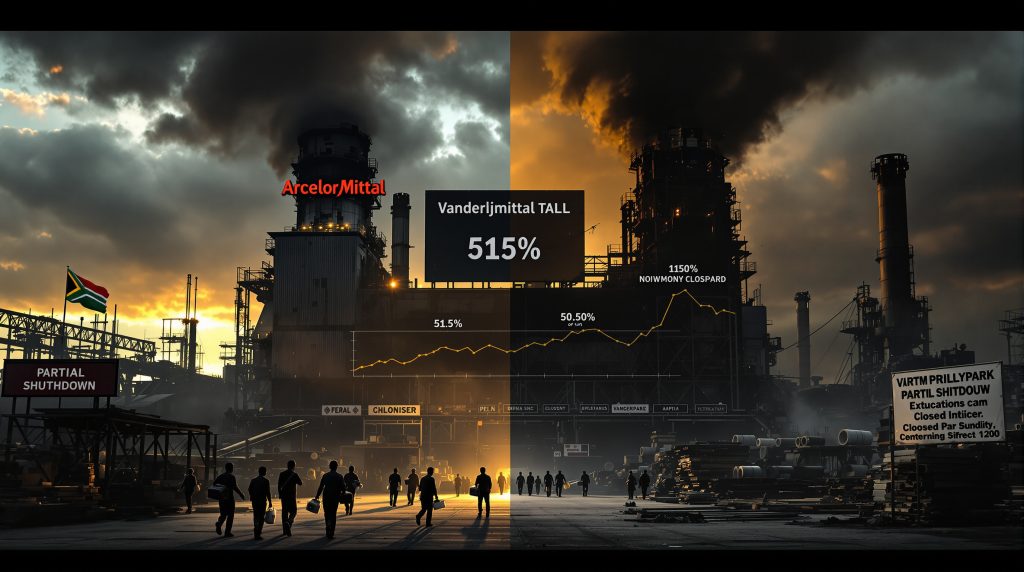ArcelorMittal South Africa's Workforce Crisis: Understanding the Escalating Job Cuts
ArcelorMittal South Africa (AMSA) is facing a critical period of restructuring, with plans to eliminate approximately 4,000 positions—nearly half of its total workforce. This significant workforce reduction exceeds the initially announced 3,500 job cuts that were expected from the closure of long steel operations, signaling a more comprehensive downsizing of the company's South African presence.
How Severe Are ArcelorMittal South Africa's Job Cuts?
The Expanding Scale of Retrenchments
ArcelorMittal South Africa's workforce reduction plan has grown substantially in scope and impact. The initial announcement focused on approximately 3,500 positions being eliminated through the closure of long steel operations. However, according to recent statements from the Solidarity union, AMSA has informed employees about "mass retrenchments involving more than 4,000 jobs," representing nearly half of the company's entire South African workforce.
This dramatic escalation indicates the severity of the challenges facing the steelmaker's operations in the country. With approximately 8,000 total employees before the cuts, this represents a 50% reduction in AMSA's human resources, fundamentally transforming the company's operational capacity in South Africa.
Beyond Long Steel: Vanderbijlpark Operations Affected
While the initial job cut announcements centered on the Newcastle and Vereeniging long steel plants scheduled for closure in September 2025, the retrenchment plan has now expanded significantly to include AMSA's flagship Vanderbijlpark operations. This facility, which specializes in flat steel production, was previously considered the company's core business in South Africa.
The inclusion of Vanderbijlpark in the restructuring plan represents a strategic shift in ArcelorMittal's approach to its South African operations. Rather than simply eliminating underperforming divisions, the company appears to be implementing a comprehensive downsizing across its entire South African footprint, including what was once considered its most valuable asset in the region.
What Factors Are Driving AMSA's Massive Workforce Reduction?
Financial Performance Deterioration
ArcelorMittal South Africa has been experiencing sustained financial challenges that have eroded its competitive position. The steelmaker has reported consistent financial losses since 2023, with a half-year headline loss of approximately 1.0 billion rand ($56 million) in its most recent reporting period.
These losses stem from multiple interrelated factors:
- Persistently low sales volumes in the domestic market, reflecting broader economic challenges in South Africa
- Depressed steel prices affecting profit margins across product categories
- Rising operational costs undermining competitiveness against both domestic and international competitors
- Increasing gap between production costs and achievable market prices
This financial deterioration has created an unsustainable business model that necessitates significant restructuring to ensure long-term viability.
Structural Challenges in the South African Market
AMSA's operations face several deep-rooted structural challenges that have steadily eroded its competitive position in the market:
| Challenge | Impact on AMSA |
|---|---|
| High electricity tariffs | Significantly increased production costs in an energy-intensive industry |
| Poor freight logistics | Disrupted supply chains and increased transportation expenses |
| Competition from scrap recyclers | Domestic market share erosion from operations with lower cost structures |
| Chinese steel imports | Price pressure and market displacement from lower-cost producers |
These challenges create a particularly difficult operating environment for traditional integrated steel production facilities like AMSA's operations. The combination of infrastructure challenges, policy issues, and international competition has created a perfect storm for the company's South African business.
Failed Attempts at Government Intervention
AMSA has twice postponed the closure of its long steel operations while seeking government support to address the structural challenges facing its business. The company requested several specific interventions from the South African government:
- Reduction of scrap export duties to level the playing field with recyclers operating in the domestic market
- Implementation of tariffs and market impact on imported steel, particularly from China, to protect domestic production
- Negotiation of favorable electricity and freight rates with state-owned utilities to reduce operational costs
Despite these efforts, negotiations have not yielded sufficient solutions to prevent the expanded job cuts. The Solidarity union has publicly criticized the government for "dragging its heels" in addressing the crisis, suggesting that more timely policy interventions might have limited the scale of the workforce reduction.
What Is the Economic Impact of AMSA's Restructuring?
Production Capacity Reduction
AMSA currently produces approximately 2.4 million metric tons of steel annually, representing about 4% of ArcelorMittal's global output. The closure of multiple facilities will significantly reduce South Africa's domestic steel production capacity, potentially creating supply gaps in certain product categories.
This reduction in domestic production capacity has several implications:
- Increased reliance on imports to meet domestic steel demand
- Potential price impacts for steel-consuming industries
- Loss of manufacturing capacity in a strategically important industrial sector
- Reduced self-sufficiency in a critical industrial input material
The long-term consequences for South Africa's industrial base extend well beyond the immediate job losses.
Sectoral Employment Effects
The steel industry serves as a crucial employer in South Africa's manufacturing sector, with jobs that typically offer above-average wages and benefits. The loss of 4,000 jobs will have ripple effects across multiple dimensions:
- Direct employees and their dependents will face immediate economic hardship
- Contractors and service providers to AMSA facilities will experience reduced business
- Downstream industries reliant on domestic steel supply may face disruptions
- Local communities where AMSA operations are centered will see reduced economic activity
These employment effects are particularly significant given South Africa's already high unemployment rate, which reached 33.9% in the first quarter of 2025, according to Statistics South Africa.
Regional Economic Impact
The communities where AMSA's facilities are located—particularly Newcastle, Vereeniging, and Vanderbijlpark—will experience concentrated economic impacts from these job cuts:
- Reduced local spending power affecting retail and service businesses
- Decreased municipal tax revenues limiting public services
- Potential property value declines in affected communities
- Secondary job losses in businesses dependent on AMSA employees' spending
These regional impacts may be particularly severe in communities where AMSA represents a significant portion of the local employment base and economic activity.
How Has AMSA's Long Steel Division Struggled?
Product Range and Market Applications
AMSA's long steel division, which includes the Newcastle and Vereeniging plants, produces a diverse range of products serving critical sectors of the South African economy:
- Construction materials including rebar, structural steel, and reinforcing bars
- Mining support products such as rock bolts and mesh for underground support
- Infrastructure components for transportation and utility projects
- Manufacturing inputs for various industrial applications including machinery
- Rail infrastructure components for South Africa's transportation network
The division's products form an essential part of the country's industrial supply chain, making its closure particularly significant for downstream industries.
Competitive Disadvantages
The long steel division has faced mounting pressure from multiple competitive sources that have eroded its market position:
- Local scrap metal recyclers operating with lower cost structures and more flexible production models
- Imported steel products, particularly from Chinese producers with state support and lower labor costs
- Rising electricity costs affecting energy-intensive processes, with South African electricity rates rising faster than global averages
- Logistical challenges increasing transportation expenses both for incoming raw materials and outgoing finished products
These competitive disadvantages have created an increasingly challenging business environment for AMSA's long steel operations, culminating in the decision to close these facilities.
Timeline of Closure Decisions
AMSA has twice deferred the closure of its long steel operations while seeking alternative solutions. The company initially announced plans to shut these facilities earlier in 2025 but extended operations while negotiating with government entities about potential interventions.
With those negotiations failing to produce viable alternatives despite multiple extensions, the closure process is now proceeding with an expanded scope that includes impacts on the Vanderbijlpark operations. This timeline illustrates the company's attempts to find solutions before implementing the more comprehensive restructuring now underway.
What Are the Broader Implications for South Africa's Industrial Sector?
Steel as a Strategic Industry
Steel production is considered a strategic industry for industrialized economies, providing essential inputs for multiple sectors:
- Infrastructure development projects including roads, bridges, and buildings
- Manufacturing sector growth requiring steel components and structures
- Construction industry materials forming the backbone of physical development
- Mining operations support for South Africa's crucial resources sector
The reduction in domestic steel production capacity may have long-term implications for South Africa's industrial self-sufficiency and development potential.
Import Dependency Concerns
With reduced domestic production capacity, South Africa may face several challenges related to increased steel imports:
- Increased reliance on imported steel products creating potential supply vulnerabilities
- Foreign exchange implications from higher import volumes affecting the national balance of payments
- Reduced industrial self-sufficiency in a strategically important material
- Exposure to international price volatility and supply disruptions
These import dependency concerns take on additional significance in a global environment of increasing trade tensions and supply chain disruptions.
Industrial Policy Challenges
AMSA's restructuring highlights broader challenges in South Africa's industrial policy framework that extend beyond the steel sector:
- Balancing protection of domestic industries against global competition while maintaining market efficiency
- Managing the cost structures of state-owned utilities to support industrial competitiveness
- Supporting strategic industries while maintaining market principles and avoiding unsustainable subsidies
- Addressing structural impediments to manufacturing competitiveness including energy costs and logistics
The government's response to AMSA's situation may set precedents for how similar challenges are addressed in other industrial sectors facing competitive pressures.
What Alternatives Were Considered Before the Job Cuts?
Proposed Government Interventions
AMSA sought several policy interventions to improve its competitive position before implementing the expanded job cuts:
- Trade Policy Adjustments: Modifications to scrap export duties and import tariffs to level the competitive landscape with both recyclers and international producers
- Utility Cost Relief: Negotiation of more favorable electricity and freight rates with state-owned enterprises to reduce operational costs
- Strategic Industry Support: Recognition of steel as a strategic sector deserving of targeted policy support similar to programs in other steel-producing nations
These proposed interventions focused on addressing the structural challenges affecting AMSA's competitiveness rather than seeking direct financial subsidies.
Industrial Development Corporation Support
The Industrial Development Corporation provided a substantial loan of 1.683 billion rand to AMSA, demonstrating recognition of the company's strategic importance. However, this financial support proved insufficient to address the fundamental challenges facing the business in the absence of broader structural reforms.
The involvement of the Industrial Development Corporation highlights the strategic importance placed on maintaining domestic steel production capacity, though ultimately financial support alone could not overcome the multiple competitive disadvantages facing AMSA's operations.
Union Engagement
Labor unions, including Solidarity, have been actively engaged in discussions regarding AMSA's future. They have advocated for government intervention to preserve jobs and maintain domestic steel production capacity, emphasizing the broader economic impacts of the potential job losses.
Despite these efforts from organized labor, the expanded job cuts indicate that neither union engagement nor government negotiations produced sufficient alternatives to prevent the comprehensive restructuring now underway.
How Will This Affect South Africa's Manufacturing Supply Chain?
Downstream Industries
The reduction in domestic steel production capacity will impact numerous downstream industries that rely on AMSA's products:
- Construction sector projects requiring steel inputs may face supply challenges or increased costs
- Automotive manufacturing operations needing specialized steel products may need to develop new supply relationships
- Mining equipment and infrastructure manufacturers may experience disruptions in material availability
- General manufacturing requiring steel components may face longer lead times or higher prices
These impacts may be particularly significant for manufacturers with specialized steel requirements that were previously met by AMSA's domestic production.
Supply Chain Adjustments
Businesses reliant on AMSA's products will need to implement several adjustments to their supply chain strategies:
- Identify alternative domestic suppliers where available, potentially including smaller specialty producers
- Establish import channels for products no longer produced locally, including relationships with international suppliers
- Potentially absorb higher costs for steel inputs due to import logistics and currency fluctuations
- Manage longer lead times for imported materials, requiring adjustments to inventory management practices
These supply chain adjustments will require significant time and resources from affected businesses, creating transition costs beyond the direct impacts of AMSA's restructuring.
Value Chain Disruptions
The reduction in domestic steel production capacity may create broader disruptions throughout South Africa's industrial value chains:
- Reduced availability of certain steel grades or specifications may force product redesigns
- Higher input costs may affect the competitiveness of South African manufactured products
- Longer supply chains may increase vulnerability to international disruptions
- Loss of specialized knowledge and capabilities in domestic steel production
These value chain disruptions represent indirect but potentially significant costs of the reduced domestic steel production capacity resulting from AMSA's restructuring.
What Does This Mean for ArcelorMittal's Global Strategy?
Portfolio Optimization
ArcelorMittal's global strategy appears to involve several key elements that provide context for the South African restructuring:
- Focusing investments on more competitive operations with sustainable cost structures
- Reducing exposure to challenging market environments with structural disadvantages
- Optimizing production capacity to match market demand and maximize efficiency
- Prioritizing operations with sustainable cost structures and growth potential
This approach represents a rational portfolio management strategy for a global steel producer operating in multiple markets with varying levels of competitiveness and growth potential.
African Market Presence
The restructuring of AMSA represents a significant reduction in ArcelorMittal's African footprint. This may indicate a strategic shift in how the company approaches emerging markets with challenging operating environments:
- More selective engagement based on structural competitiveness factors
- Higher hurdle rates for continued investment in challenging markets
- Greater focus on sustainable long-term profitability versus market presence
- Strategic reallocation of resources to more promising regional markets
This strategic realignment may have implications for ArcelorMittal's approach to other emerging markets with similar structural challenges.
Global Production Rebalancing
The reduction of South African production capacity (approximately 2.4 million metric tons annually) represents about 4% of ArcelorMittal's global output. This production may potentially be shifted to more cost-competitive locations within the company's global network:
- Facilities with lower energy costs and more efficient logistics
- Operations with stronger local market growth potential
- Plants with more favorable labor productivity and cost structures
- Locations with supportive industrial policies and infrastructure
This global rebalancing reflects the increasingly competitive nature of the international steel industry and the importance of structural advantages in determining facility viability.
What Lessons Can Be Learned from AMSA's Situation?
Industrial Competitiveness Factors
AMSA's challenges highlight several critical factors affecting industrial competitiveness in energy-intensive manufacturing sectors:
- Energy Costs: The impact of high electricity tariffs on energy-intensive industries creates a fundamental competitive disadvantage that can be difficult to overcome through operational improvements alone
- Logistics Infrastructure: The importance of efficient freight systems for heavy industry handling bulk materials and finished products affects both cost structures and reliability
- Trade Policy Balance: Finding appropriate levels of protection versus competition requires careful calibration to support domestic industry without creating inefficiencies
- Structural Reform Needs: Addressing fundamental economic constraints often requires coordination across multiple policy domains
These competitiveness factors extend beyond the steel industry to affect other manufacturing sectors in South Africa and similar emerging markets.
Government-Industry Coordination
The case demonstrates the importance of effective coordination between multiple stakeholders to address complex industrial challenges:
- Industrial policy makers setting the framework for sector development
- State-owned enterprises providing essential infrastructure and services
- Private sector manufacturers making investment and operational decisions
- Labor organizations representing worker interests and providing industry insights
More effective coordination among these stakeholders might have produced more sustainable solutions to AMSA's challenges before they reached the critical point of massive job cuts.
Proactive Restructuring Approaches
AMSA's situation illustrates the potential consequences of delayed action in addressing structural challenges in industrial operations. Earlier, more gradual restructuring might have preserved more jobs and production capacity through:
- Phased capacity rationalization matched to market conditions
- Focused investments in the most competitive operations
- Strategic partnerships to address specific structural challenges
- Gradual workforce adjustments through attrition and retraining
The scale of the current job cuts suggests that opportunities for more gradual adjustments may have been missed through delays in addressing the fundamental challenges.
What's Next for South Africa's Steel Industry?
Remaining Production Capacity
Following AMSA's restructuring, South Africa's steel industry will rely on a reconfigured production landscape:
- Remaining AMSA operations with reduced capacity focused on the most viable product segments
- Smaller domestic producers and mini-mills serving specialized market niches
- Scrap metal recyclers producing certain steel products with different cost structures
- Specialized steel product manufacturers focusing on high-value segments
This reconfigured landscape will have implications for both the industry's overall capacity and its product mix capabilities.
Import Dynamics
The country will likely experience significant shifts in steel trade patterns:
- Increased steel imports to fill domestic supply gaps, particularly for products previously manufactured by AMSA
- Potential price impacts from import reliance, including currency fluctuation effects
- Shifts in trade relationships with major steel-producing nations including China
- Possible trade policy adjustments to manage the transition to higher import dependence
These import dynamics will require careful management to minimize disruption to steel-consuming industries during the transition period.
Future Investment Outlook
The challenging environment for steel production in South Africa may affect investment patterns in several ways:
- Limited new investment in large-scale integrated steel production given the demonstrated structural challenges
- Potential opportunities for smaller specialty producers serving specific market niches
- Increased focus on downstream value-added manufacturing using imported steel inputs
- Possible development of more flexible production models less vulnerable to structural challenges
The future investment landscape will likely favor more agile, market-responsive business models over large-scale capital-intensive operations like AMSA's traditional facilities. Furthermore, opportunities for mineral beneficiation in South Africa may become increasingly important as the country seeks to maintain value addition in its resource sectors despite the challenges facing traditional steel production.
FAQ: ArcelorMittal South Africa Job Cuts
When will the job cuts at ArcelorMittal South Africa take effect?
The job cuts are expected to be implemented following the closure of the long steel plants at Newcastle and Vereeniging, which was scheduled for September 2025. The expanded cuts affecting Vanderbijlpark operations will likely follow a similar timeline, though specific dates for those reductions have not been publicly confirmed by the company.
How many workers will remain at AMSA after the cuts?
With approximately 4,000 positions being eliminated from a workforce that numbered around 8,000, AMSA will retain roughly 4,000 employees across its remaining operations. This represents a dramatic downsizing of the company's South African presence, focusing on its most viable production lines and facilities.
What support will be provided to affected workers?
South African labor laws require companies undertaking large-scale retrenchments to engage in consultation processes and provide severance packages. AMSA will be obligated to provide statutory severance payments based on length of service. Additional support measures may include skills development programs, job placement assistance, and potential preference for rehiring if conditions improve, though specific details beyond legal requirements have not been publicly announced.
Could the government still intervene to reduce the number of job cuts?
While government intervention remains theoretically possible, the Solidarity union's statements suggest that the window for effective intervention may have closed. The union has criticized the government for delays in addressing AMSA's concerns, indicating that the restructuring process has advanced beyond the point where it could be significantly altered without extraordinary measures.
Will AMSA completely exit the South African market?
Current information does not suggest a complete exit from South Africa. Rather, AMSA appears to be significantly downsizing its operations to focus on potentially viable segments of its business. The company will maintain a presence in the country, albeit with substantially reduced production capacity and workforce. This restructured operation will likely focus on the most competitive product lines and facilities within the company's South African portfolio, while continuing to monitor iron ore price trends and iron ore demand insights that could impact future mining consolidation trends.
Looking to Spot the Next Major Mineral Discovery on the ASX?
Discovery Alert's proprietary Discovery IQ model provides instant notifications when significant ASX mineral discoveries are announced, empowering subscribers to identify actionable investment opportunities ahead of the broader market. Explore historic discoveries and their returns on our dedicated discoveries page and position yourself for success in the resource sector.




